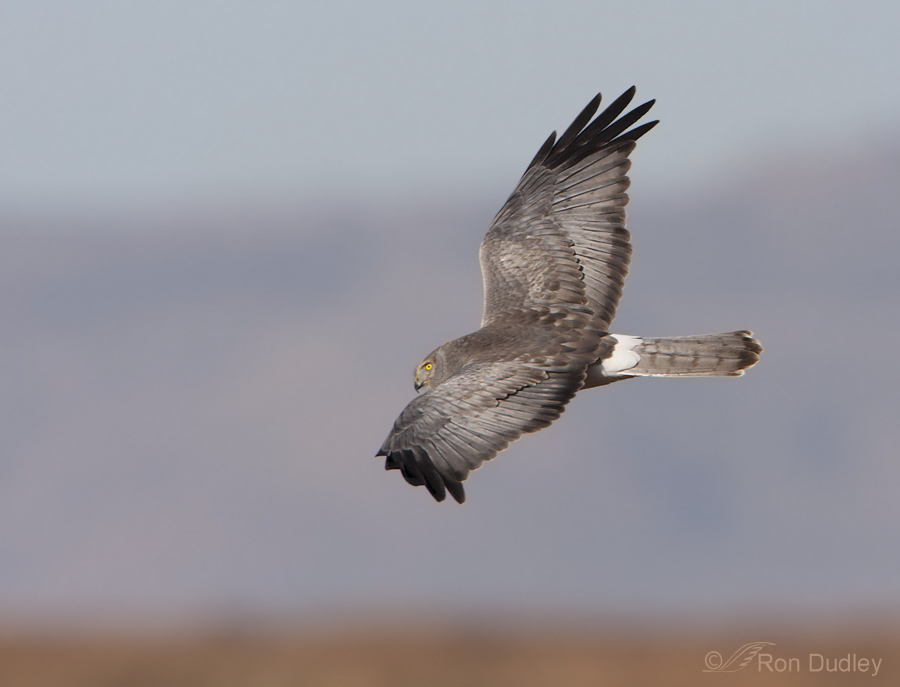For me the background can sometimes be almost as important as the bird. In this case it’s probably because I identify so personally with what’s back there, even though it’s all out of focus. This place is where I cut my photographic teeth years ago.
1/1600, f/8, ISO 400, 500 f/4, 1.4 tc
As I’ve said before I prefer something other than featureless sky in my backgrounds of birds in flight. Here there are three distinct horizontal layers, top to bottom – sky up top, the phragmites of Farmington at bottom and the large purplish band in the middle is Antelope Island in the far-off background. There’s even a fourth, less noticeable layer between the island and the phrags – a (subtle) thin horizontal blue line that is the water where an arm of the Great Salt Lake meets the Farmington marshes.
Yesterday I rediscovered this older image of a male Northern Harrier performing a mild bank against a backdrop that I know so well. With my 500mm lens + tc I get such a small piece of the background in the image that it’s usually a solid color of sky or, less often, vegetation. So this time I was pleased to get so many recognizable elements in the background.
Ron



Fantastic shot Ron!
Charlotte
A dream shot. The background can’t be improved upon. And the light on the bird, the gun metal gray contrast to the background… Nice work!
Simply superb! The background is the perfect backdrop for the male’s coloration. A magnificent raptor portrayed perfectly, Ron!
I’m hooked on the bird in this one, rather than the background, although it is something I usually like to see!
When I say slap “it” between two graham crackers, I didn’t mean the stick!
Beautiful bird and I appreciate the thoughtful photography insights. Happy holidays to you, sir!
Thank you, Nala. Happy holidays to you, also.
Those layers add drama, to an already dramatic (and beautiful) bird. Thank you.
I’m glad you like the background layers, Elephant’s Child.
Just looked at this image again and am convinced your WERE flying right next to him….admit it!!!
I wish I had been, Patty. Flying with a harrier would be a blast!
A blast, maybe, but are you ready to eat voles???
I once at a gopher – does that count? Actually, I hope I’ve consumed my last rodent…
Ron, you’d make a terrible southerner, then, because they love their squirrel and dumplings… I’ve had that once and it was pretty tasty as I remember (not sure I’d want it again, though, because rabbit was good the first time I had it, but tasted awful on a later try).
My gopher was roasted on a stick over a fire. Next time I’ll just eat the stick…
YUK!!!
Roasting on a stick sounds OK…IF, you slapped it between two graham crackers and half of a large Hersey bar. I’ll bet if you did that you’d want s’more!
You are soooooo bad, Patty! Thanks for a great laugh. My husband and I both really enjoyed your comment.
God only knows what you were thinking , Susan…I meant the GOLPHER!!!
I promise you it wasn’t bad, Patty. We were just thinking about the s’more idea. With the gopher. We just liked the idea of making s’mores that way.
Wait ’til you try ’em!!!
I thought you Pthought I meant the stick…that’s what he said he’d eat the next time! …and so around and around it goes!
Love this view of this beautiful bird…don’t see the top side and it’s subtle colors that often…makes me feel as if I’m flying along side of him…I like that!
I notice in many of your photos that the subject is clear and the background is not. (don’t know if out of focus is a correct reference or not). Being a beginner, how is that effect attained?
Todd, it’s called “bokeh” and the effect is obtained by using a telephoto lens where your depth of field is very shallow. Some lenses do a better job of it than others – my Canon 500mm f/4 has a reputation for pleasing bokeh.
Hard to beat a male Harrier for beauty! Love it Ron.
Thanks, Jerry. Yup, the male is a stunner.
I like the different layers as well. Great shot!
Thank you, Jean.
Love the wing and eye position! Great capture!
Glad you like it, Bob. Thank you.